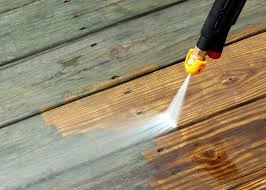Deck Discoloration 101: Every Little Thing You Required to Know for a DIY Job
From preparing the deck surface to picking the appropriate kind of discolor and mastering the application techniques, each step plays an essential role in achieving a professional coating. Join us as we decipher the crucial guidelines and insider tips for grasping the art of deck staining, ensuring a successful DIY job that will certainly leave your deck looking remarkable.
Value of Deck Staining
Deck discoloration is a vital upkeep task that preserves the durability and look of outdoor wood frameworks. By applying a coat of tarnish to the deck's surface area, you produce a safety barrier that helps prevent dampness penetration, UV damages, and decaying of the wood.
Moreover, deck discoloration boosts the all-natural appeal of the wood by highlighting its grain and structure. It offers an opportunity to tailor the appearance of the deck by selecting from a range of stain coatings and colors. Whether you favor a clear stain that showcases the timber's all-natural shade or a strong stain that includes a pop of color, the appropriate discolor can elevate the general aesthetic of your exterior living room. In essence, regular deck staining is a simple yet effective way to guarantee your deck remains structurally sound and aesthetically pleasing for years to come.
Deck Prep Work Tips

After cleaning and fixing, fining sand the deck is essential to smooth out harsh surfaces and open up the timber's pores to far better soak up the tarnish. When the deck is tidy, completely dry, and smooth, protect any kind of close-by plants, furnishings, or surfaces with a decline cloth prior to applying the deck tarnish.
Picking the Right Discoloration
Selecting the ideal discolor for your deck is an essential decision that straight impacts both its appearance and longevity. When picking the appropriate tarnish, there are numerous variables to think about to ensure an effective DIY task.
To start with, you require to choose in between transparent, semi-transparent, and strong discolorations. Transparent discolorations allow the natural grain of the wood to show via but provide very little protection against UV rays and dampness. Semi-transparent stains give a compromise between color and defense, while strong stains provide one of the most defense however cover the wood grain.
Next, consider the kind of wood your deck is made from, as various discolorations function better with particular timber types. Cedar and redwood decks commonly look finest with a semi-transparent or clear discolor to highlight their natural elegance. Pressure-treated timber may take advantage of a solid discolor to conceal flaws.
Last but not least, consider the climate in your area. Choose for a discolor with UV defense and resistance to extreme climate problems if you experience rough winter seasons or extreme sunshine. By thoroughly thinking about these components, you can pick a tarnish that enhances your deck's visual appeals and longevity.

Applying Discoloration Effectively
When taking into consideration the application of tarnish to your deck, it is necessary to pay attention to the details qualities of the stain chosen and just how it engages with the kind of wood and ecological conditions previously mulled over. Prior to starting the staining procedure, make certain that the deck surface is clean, this website completely dry, and devoid of any type of previous coatings or particles. It is advised to test the picked discolor on a small low-profile location of the deck to make sure compatibility and achieve the wanted shade and coating.
Apply the stain along the size of the deck boards to prevent uneven pooling - deck cleaning services. It is important to function with the timber grain to improve the natural elegance of the deck and allow for better infiltration of the stain.
Maintenance and Treatment Tips

An additional vital aspect of deck upkeep is safeguarding it from the elements. Consider using a waterproof sealant every couple of years to shield the wood from moisture damages. In addition, dealing with any mold and mildew or mildew without delay is important to prevent them from triggering architectural harm to your deck. Consistently cutting neighboring foliage can also protect against leaves and branches from accumulating on your deck and creating possible damage.
Verdict
To conclude, deck discoloration is a crucial step in preserving the look and longevity use this link of your outdoor area. By properly preparing the deck, selecting the appropriate stain, applying it properly, and following maintenance tips, you can ensure a resilient and attractive coating that will last for years ahead. Bear in mind to regularly care and check for your discolored deck to keep it looking its ideal.
Join us as we unravel the essential standards and expert pointers for understanding the art of deck discoloration, making certain a successful DIY task that will leave your deck looking flawless. - deck cleaning services
In essence, regular deck discoloration is an easy yet effective way to ensure your deck continues to be structurally sound and visually pleasing for years to come.
When the deck is clean, dry, and smooth, protect any type of close-by plants, furniture, or surface areas with a drop towel before using the deck stain.Following, consider the kind of wood your deck is made of, as various discolorations function much better with specific wood varieties.When taking into consideration the application of tarnish to your deck, it is necessary to pay close interest to the particular features of the stain picked and exactly how it connects with the kind of timber and ecological problems formerly deliberated.